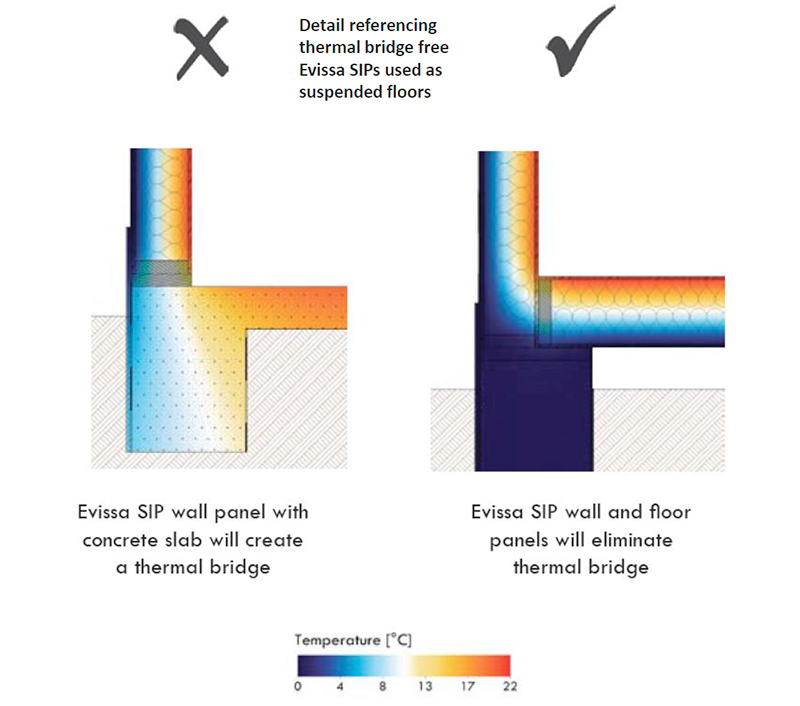Combining Passivhaus & Evissa SIPs for Energy Efficiency
When it comes to operating our homes, energy efficiency is important. Similar to how our bodies require energy from food to sustain themselves, our homes also require energy. Suppose we were to extend this analogy to construction and view the energy expended in building structures in a manner similar to how we assess our own calorie consumption.
Calories in food provide energy for our bodies to function; similarly, our dwellings also need calories to keep us warm or cool and maintain the appropriate ventilation levels across the seasons. In our example, a calorie measures the amount of heat needed to raise the temperature of one gram of water by one degree Celsius. Our energy bills show how many calories our buildings use, these are expressed in Kilo Joules or KWh, with 1 Kilocalorie = 4,184 Kilojoules = 0.00116222 KWh.
A study by the CSIRO reported that the average daily energy consumption for a standard dwelling in Australia is 41.3KWh, which equates to 15,075KWh per year. When Passivhaus standard and SIPs are used in the construction process, not only does it produce healthier living spaces, but also more energy efficient outcomes. A Passivhaus dwelling can use up to 90% less calories (energy) compared to a traditional built dwelling of the same size. Using around 4.13KWh per day or 1,507.5KWh per year.
The key to achieving this significant energy reduction is where building physics comes into play and how the external building fabric is constructed. When you create a highly resilient coat that is continuously insulated without any weak gaps, is airtight, allows for controlled solar gains and is optimised for ventilation, you get a far less hungry home.
Energy efficiency for a dwelling built with Passivhaus standards and SIPs
Homes constructed with Passivhaus standards and Structural Insulated Panels (SIPs) have the potential to yield substantial energy savings, with a potential reduction in energy bills by as much as 90% when compared to a traditional 6-star rated home. This remarkable efficiency is a testament to the innovative design and construction methods employed in Passivhaus and SIP buildings.
To put this into perspective, the energy consumption of a conventional dwelling could be equivalent to powering up to 10 Passivhaus SIP buildings of identical size. This stark contrast underscores the significant impact that adopting energy-efficient building practices can have on both individual households and broader sustainability goals. By embracing technologies like Passivhaus and SIPs, we not only enhance the energy efficiency of our homes but also contribute to a more sustainable and environmentally conscious approach to housing construction.
Why is energy efficiency important in the dwellings Evissa designs?
Australian power prices have risen 117% since 2018, the Australian Energy Regulator approves further pricing changes on the 1st of July each year which can be anywhere between 5% - 10%. So having alternative energy efficient construction methods are needed more than ever.
With the rise in popularity of green energy and off the grid living, we now have more flexibility when it comes to the amount of energy we can harvest and how the excess can be redistributed back into the grid or through peer-to-peer sharing.
Moreover, as we gradually transition away from homes reliant on fossil fuels, there will be an increasing demand for electricity. This surge in demand positions electricity as a focal point for potential cost hikes.
Energy efficiency using Passivhaus Standards and SIPs
Utilizing SIPs as the primary construction method for dwellings, will enable the following advantages:
Insulation
Using SIPs in the construction process, provides excellent insulation across all sides of the external envelope, including floors, walls, and roofs.
Controlled Solar Gains
Solar power plays an integral role in Passivhaus and SIPs builds, making use of natural resources, the surrounding environment, clever design and technology. When an 8KW Photovoltaic System (solar panels) and battery are added to the build, the dwelling can easily function with zero energy bills.
Neighbouring buildings and trees can also actively reduce the summer heat and provide shade for habitable spaces, while north facing orientation will enable good use of sunlight across the whole day, irrespective of the season.
Integrating the right type of glazing, balanced sized windows, and appropriate awnings can enable full access to the winter sun and reduce heat from the summer sun.
Zero Thermal Bridge aka TB
Thermal bridges are the number one culprit in energy efficient buildings. The higher the insulation levels, the higher the risk of TB occurrence. In a Passivhaus SIPs building TB can be present in a linear shape or as point TB. The linear TB is usually present along the edge of a slab, or along the ridgeline.

The point TB are protrusions occurring through the building fabric caused by metal beams.

Fine and narrow air gaps can also cause thermal bridges, so it’s important to tape and seal all joints to reduce this hazard. Implementing a building envelope constructed entirely with Evissa SIPs and timber framing ensures a construction that is free from thermal bridges.
Airtight
Building tight is right. All air gaps will prevail air movement, loss of energy and promote TB presence. Evissa SIPs covered with airtight, and vapour permeable membranes achieve very low air tightness levels compliant with Passivhaus requirements (0.6 airch/hour @50Pa pressure difference testing).
Ventilation
Being able to ventilate an indoor space naturally or mechanically is key to maintaining good levels of Indoor Air Quality. It is becoming mandatory to have a ventilation method in place for all airtight spaces. All Passivhaus and SIPs buildings adopt a centralised or decentralised heat recovery ventilation system to enable 24/7 ventilation cycle which runs on minimum energy use.
When all these features are combined you have a comfortable, energy efficient, healthy, and much less hungry home.
Contact us for more information on how you can incorporate Passivhaus standards and Evissa SIPs into your next project.
Learn about : Is you building making you sick?